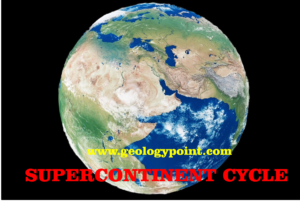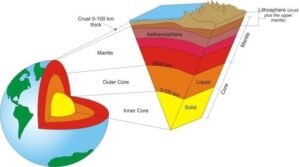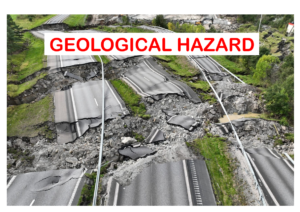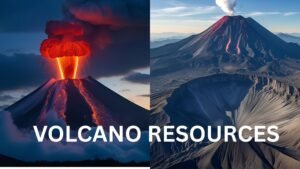Introduction
At first glance, continents appear to be fixed features of our world. However, they move, drift, collide, and disintegrate in a gradual and magnificent pattern known as the Supercontinent Cycle throughout geological time. Over hundreds of millions of years, this cycle has repeatedly changed the surface of Earth, creating and dissolving enormous landmasses known as supercontinents. Similar to the ebb and flow of tides or the changing of the seasons, the creation and fragmentation of supercontinents are regular occurrences. It has a significant impact on tectonic activity, biodiversity, climate, resource distribution, and the ocean and land. In this article, we will discuss about the phenomenon of the supercontinent cycle.
What is a supercontinent?
A supercontinent is a sizable landmass that is made up of most or all of the continental crust of Earth. The slow, unrelenting movement of the Earth’s lithosphere, caused by mantle convection, causes tectonic plates to converge, resulting in the formation of these continents. There is a cycle in the process; it is not random. Over geological time, continents frequently converge to form supercontinents, which separate and drift to different locations before re-occurring. We refer to this broad tectonic cycle as the Supercontinent Cycle.
Timeline of supercontinents:
Earth has experienced five or more supercontinents in its 4.6-billion-year geological history. While the exact number and timing are debated, geologists generally agree on the following major supercontinents:
- Vaalbara (~3.3–2.8 billion years ago) – Possibly Earth’s first supercontinent.
- Ur (~3 billion years ago) – Considered one of the earliest cratonic aggregations.
- Kenorland (~2.7–2.1 billion years ago) – Formed during the Paleoproterozoic Era.
- Columbia (also called Nuna, ~1.8–1.5 billion years ago) – Linked to major global tectonic and magmatic events.
- Rodinia (~1.1 billion–750 million years ago) – Broke apart to trigger the Cryogenian “Snowball Earth.”
- Pannotia (~600 million years ago) – A short-lived supercontinent before the rise of Gondwana and Laurasia.
- Pangaea (~335–180 million years ago) – The most well-known supercontinent, whose breakup gave rise to today’s continents.
These successive supercontinents have left their fingerprints in the form of ancient mountain belts, igneous intrusions, sedimentary basins, and paleomagnetic records preserved in Earth’s crust.

What are the driving forces behind the supercontinent cycle?
The supercontinent cycle is fundamentally governed by plate tectonics – the large-scale movement of Earth’s lithospheric plates. These tectonic processes operate through three primary mechanisms:
Mantle convection:
Mantle convection is the primary driver of plate tectonics and the supercontinent cycle, acting as Earth’s internal heat engine. This process occurs as heat from the core and radioactive decay causes the mantle’s rocky material to slowly circulate in convection currents – hotter, less dense material rises while cooler, denser material sinks. These massive convection cells extend throughout the mantle, creating forces that fracture the lithosphere into tectonic plates and move them across Earth’s surface. At mid-ocean ridges, upwelling mantle material generates new crust, pushing plates apart, while downwelling currents at subduction zones pull plates together. Over hundreds of millions of years, this relentless process assembles and breaks apart supercontinents: rising plumes weaken and rift supercontinents apart, while descending currents eventually drag continents back together in a new configuration. Evidence for this mechanism comes from seismic tomography revealing convection patterns, the global distribution of volcanoes and earthquakes along plate boundaries, and paleomagnetic records showing past continental motions. Without this convective engine, Earth would lack the dynamic surface that has shaped our planet’s geology, climate, and evolution of life.
Slab pull and ridge push:
Slab pull and ridge push are the two dominant forces driving plate tectonics, working in tandem with mantle convection to move Earth’s lithospheric plates. Slab pull, the more powerful of the two, occurs when dense oceanic lithosphere sinks into the mantle at subduction zones, creating a downward pulling force that drags the rest of the tectonic plate behind it. This mechanism accounts for up to 90% of the force moving plates and explains why plates with active subduction zones, like the Pacific Plate, move the fastest (8-10 cm/year). Ridge push, while less forceful, provides important additional motion as the elevated mid-ocean ridge system pushes plates apart due to gravitational forces acting on the higher, younger crust near spreading centers. Together, these forces translate the broad convection currents of the mantle into the specific, directional movements of tectonic plates that ultimately drive the supercontinent cycle – slab pull bringing continents together at subduction zones while ridge push helps break them apart at divergent boundaries. The balance between these forces determines both the speed and direction of plate motions that have shaped Earth’s surface for billions of years.
Insulation and heat build-up:
Once a supercontinent forms, it acts as an insulating blanket over the mantle, trapping heat below. Over millions of years, this heat buildup can cause upwelling plumes and continental rifting, ultimately tearing the landmass apart.
Stages of the supercontinent cycle
The cycle unfolds over 300–500 million years and typically follows four major stages:
Assembly:
Continents drift together through subduction-driven collisions, forming mountain belts and large-scale crustal thickening. This is the stage when a supercontinent takes shape.
Stability:
Once assembled, the supercontinent enters a relatively stable phase. It modifies global climate, ocean circulation, and biological evolution due to its sheer size and location.
Rifting:
Over time, mantle heat trapped beneath the supercontinent causes it to domically uplift and stretch. Rifting begins as large valleys and fissures form, eventually splitting the landmass.
Dispersal:
Rifting leads to the birth of new ocean basins and drifting continents. The former supercontinent fragments into smaller landmasses, setting the stage for the next cycle.
Impact of supercontinent cycles on Earth systems
The supercontinent cycle doesn’t just rearrange continents; it affects nearly every system on Earth:
Climate regulation:
The position of continents affects ocean circulation patterns, which in turn influence global climate. For example, the breakup of Pangaea led to more dynamic ocean currents and climate zonation.
Evolution and biodiversity:
Supercontinent assembly often leads to species isolation and extinction, while breakup facilitates diversification and speciation. The evolution of early life, including the Cambrian explosion, coincides with the fragmentation of Rodinia.
Mountain building and erosion:
Collision zones during assembly form orogenic belts (mountain ranges), such as the Himalayas today. These mountains eventually erode, supplying sediments to surrounding basins and influencing sea level and sedimentation patterns.
Mineral and energy resources:
Supercontinent cycles are tied to the formation of mineral deposits. For example, collisional zones are rich in gold, copper, and rare earth elements, while rift basins are targets for hydrocarbon exploration.
Are we headed toward a new supercontinent?

Some geoscientists believe we’re in the middle of another supercontinent cycle. The Atlantic Ocean is widening, but subduction is active around the Pacific. Several hypotheses have been proposed for the next supercontinent:
- Pangea Proxima: Forming near the same location as Pangaea.
- Novopangaea: Resulting from closure of the Pacific Ocean.
- Aurica: A symmetrical supercontinent centered around the equator.
- Amasia: Where all continents migrate northward to the Arctic.
Though such formations are 200–300 million years in the future, understanding the past helps us model what lies ahead.
Frequently Asked Questions About the Supercontinent Cycle
What is the supercontinent cycle?
The supercontinent cycle describes Earth’s recurring pattern where continents merge into a single landmass, break apart, and reassemble over 300–500 million years. It’s driven by plate tectonics and mantle convection.
How long does a full supercontinent cycle take?
Each cycle lasts 400–600 million years. The last supercontinent, Pangaea, formed ~335 million years ago and broke up ~175 million years ago. The next may form in 200–250 million years.
What causes supercontinents to break apart?
- Mantle plumes: Hot upwellings weaken the crust.
- Rift valleys: Tectonic forces split continents (e.g., East African Rift).
- Seafloor spreading: New ocean crust pushes continents apart.
What was Earth’s first supercontinent?
Vaalbara (3.6 billion years ago) may have been the earliest, but Kenorland (2.7 billion years ago) is better documented.
What will the next supercontinent look like?
Two leading theories:
- Amasia: The Pacific Ocean closes, merging Asia and the Americas.
- Pangaea Proxima: The Atlantic recloses, reuniting former Pangaea continents.
How does the supercontinent cycle affect life?
- Climate shifts: Altered ocean currents trigger ice ages or warming.
- Evolution: Isolation creates new species; collisions cause extinctions.
- Oxygen levels: Affected by continental weathering and volcanic activity.
What evidence proves past supercontinents?
- Matching rock layers across oceans (e.g., Brazil-West Africa).
- Fossil distributions (e.g., Glossopteris fern on multiple continents).
- Paleomagnetism: Records ancient continental positions.
Could humans survive the next supercontinent?
While humans likely won’t exist in their current form, future species may adapt to:
- Extreme weather from vast inland deserts.
- New ecosystems in merged continental interiors.
How does the cycle impact Earth’s oceans?
- Ocean basins expand during breakup (e.g., the Atlantic today).
- Oceans disappear during assembly (e.g., the Tethys Ocean before Pangaea).






Very informative and fantastic structure of written content, now that’s user friendly (:.